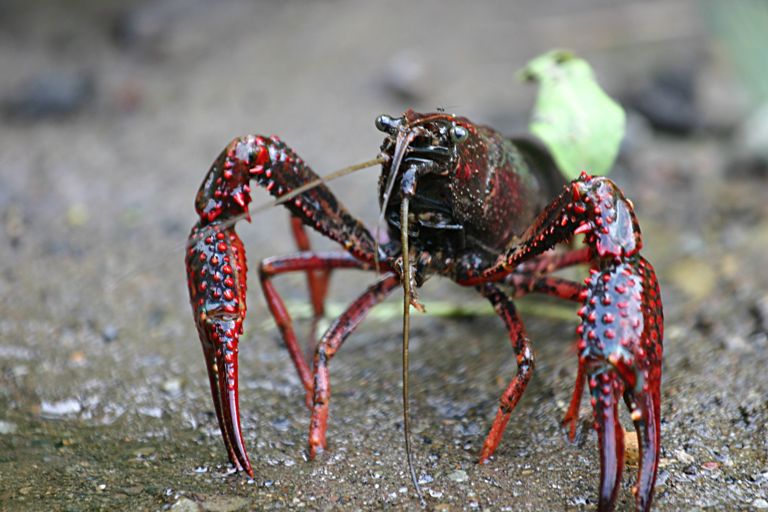
Source
Some to human activities that have to do with species management, can give the introduction of some organisms in ecosystems that are not their territories. The geographical distribution of species and the expansion of their territories are long processes that are due to different circumstances that include the transfer by humanity to farms and areas of programmed management, including sanctuaries.
Recently we have attended the news of the reintroduction of the Tasmanian Devil (Sarcophilus harrisi) in Australia. In this sub-continent country, the cats and foxes brought by the settlers, endangered species of small size. The reintroduction of the Tasmanian Devil, has its ecological advantages, because it scares away those cats and foxes.
In Colombia we have the case of the introduction of the red crab or Louisiana Crab, with the scientific name Procambarus clarkii, for breeding purposes. The red crab gringo or Procambarus clarckii, is a red crab that looks like a shrimp, voracious, native of wetlands and rivers in the southeastern United States, according to news reports, has become a problem in Bogota. It seems to be a local case, but it could reach other departments and other countries, so we must make it known.
Environmentalists and Venezuelan environmental authorities are on the alert for gringo crabs introduced into Colombia, because it has become an ecological problem. Kolar and Lodge (2001) said that an introduced species is a species that was taken from one ecosystem to another, establishing itself and causing damage to biological diversity or to the structures and functioning of society.
And Colombia is not the only country with the introduction of the red crab, Nalepa and Scholesser in 1993, indicate the introduction and presence also in many countries in different latitudes. In Spain it is reported in the news that this red crab is an invader and has become the main diet of its predators, in the Guadalquivir, meaning proliferation, developing a large population.
It arrived there in 1973, from a farm in the area of Puebla, and at the beginning of the eighties this population was "consolidated", becoming more than fifty percent of the diet of predatory species of these aquatic spaces .
It alters the trophic chains, destabilizing them by modifying the flow of energy, with the consequence of the exhaustion and displacement of species. It reproduces intensely eating smaller species in large quantities, competing, displacing from their territories and endangering the crabs of the region and the species that serve as food.
The diet of the red crab is wide and varied. Carton (1996) and Lodge (2001) identify the introduction of species as a threat to local biological diversity.
He enters the Valle del Cauca area, as a project of his breeding, but he escaped for different reasons
Colombian environmental authorities are concerned and have issued a warning. They have asked the people not to manipulate or feed them, much less consume them. The Secretary of the Environment of Bogotá recommends:
“Avoids direct handling.
Don't throw objects at them that could hurt them.
Don't take it.
Do not provide food.
Report them to the numbers: 3174276828, 3183651787, 3182154047”
Erotic imagery recommends it as an aphrodisiac, revitalizer for sexual potency, which has been surpassed by sildenafil (Viagra). That is why authorities warn that its handling as food for humanity is questioned by the great amount of harmful bacteria and viruses..
There is a whole environmental program to control this invasive species of Colombia. The measures are framed within three lines of action: "research" on its ethology (science that studies the behavior of the species), "control mechanisms, management and final disposal" (which includes hunting or capture) and "dissemination and training". The capture or hunting can be done with traps, throwing of fishing nets, among others.
The strategy is of higher quality if prevention is done, the first one not introducing the species in the wetlands and rivers, the second one is its early detection because one of its characteristics is its walk on the ground emerged for its dispersion). Burrows are well known and alter the distribution of lake banks. An inventory of the red crab should be made and the magnitude of the invasion should be known.
Although this problem has been around for some time, it has been aggravated by the mobility of the crab. That is why the environmentalists and environmental authorities of Venezuela, we are alert with the gringo plague that is in Colombia, the red gringo crab can enter if it continues to advance in the geography towards our country. There are more than a few fellow countrymen in that town, Bogotá, who could help it transcend more quickly.
PLAN DE MANEJO Y CONTROL DEL CANGREJO ROJO AMERICANO (PROCAMBARUS CLARKII) EN LA JURISDICCION CAR. Corporación Autónoma Regional de Cundinamarca CAR Dirección de Modelamiento, Monitoreo y Laboratorio Ambiental. Bogotá, Septiembre 2016. https://www.car.gov.co/uploads/files/5b7c66651ce85.pdf